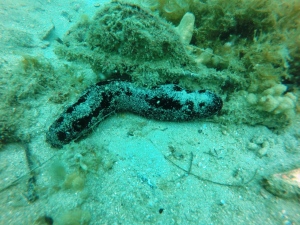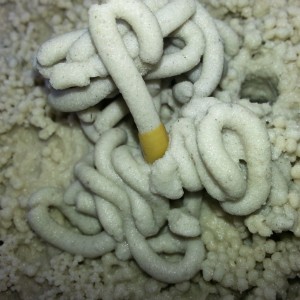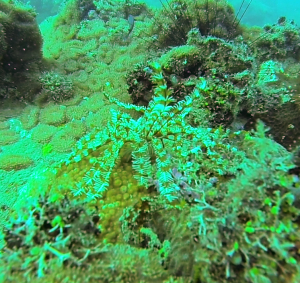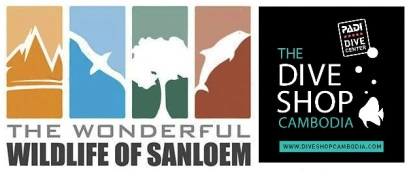Here are some of the echinoderm species we have documented and identified so far on the island, with some interesting information to wet your wildlife appetite. If you click on the picture you can learn more about them and why they are important to the islands ecosystem and us.
Order: Aspidochirotida – Sea cucumber
Family: Holothuriidae
Black spotted sea cucumber (Bohadschia graeffei) IUCN REDLIST: Least Concern

This species is commonly found along the seas floor sifting through sand and consuming organic matter during the day. when they are threatened they produce a toxin that prevent nerve impulses almost like cocaine, however they only produce this under extreme stress. Studies have shown this toxin could be beneficial as painkillers or as anti tumor drugs as results have shown positive when reducing liver tumor growth. Juveniles resemble varicose wart slugs which are toxic.
Family: Holothuriidae
Lollyfish sea cucumber (Holothuria atra) IUCN REDLIST: Least Concern

This sausage shaped sea cucumber can grow up to 60 cm in length and hides it’s self by coating it’s self with sand. It lives in the shallows preferring water with higher oxygen levels. it shares the same feeding habits as other sea cucumbers but it’s form of defense is different. rather than exuding a toxins, it throws up it’s insides through it’s anus (which it can regenerate), or a toxic red fluid. It has a relationship with the sea cucumber crab which removes and consumes any parasites. They are also consumed by humans especially in the area of Asia.
Family: Holothuriidae
Snakefish (Holothuria coluber) IUCN REDLIST: Least Concern

This species is usually found in coral reef and lagoon areas crawling over sand and rubble. this species feeds on plankton filtering plankton from the water. They usually have their own personal groomer and body guard either; crabs, shrimp and also pearlfish that perform colonial irrigation to keep them healthy. like most sea cucumbers juveniles mimic toxic seas slugs and they can also expel their intestines which amazingly they can regenerate.
Family: Stichopodidae
Eye-spotted sea cucumber (Stichopus ocellatus) IUCN REDLIST: Data Deficient

*** Further research required***
Family: Synaptidae
Conspicuous Sea Cucumber (Opheodesoma spectabilis) IUCN REDLIST: Not Evaluated

Synaptid species are suspension feeders catching plankton out of the water column. Their thin skin is embedded with tiny hooks used to cling to anything it comes in contact with. For this reason they are easily damaged when handled, especially with gloves. The body is able to expand and contract a great deal using water pressure.
***Further research required***
Order Camarodonta – globular sea urchins
Family: Temnopleuridae
Bells sea urchin (salmacis belli) IUCN REDLIST: Not Evaluated

***Further research required***
Order: Capitellida – polychaete worm
Family: Arenicolidae
Lugworm (Arenicola marina) IUCN REDLIST: Not Evaluated

Lugworms are rarely seen and their piled coils of sand are their only evidence. They have a similar appearance to earth worms, with a blackish-red head to the stomach if you will which is larger and red and at thend the yellowish red tail. The middle part has bristles along its sides and also pairs of feathery gills which can increase the uptake of oxygen. Once it burrows into the sand a lug-worm seldom leaves it. For 2 days in early october all lug-worms release their gametes (Sperm and eggs) for fertilization. They feed on plankton in the sediment that they consume and excrete which results in those tubular piles you find on the sand.
Order: Comatulida – Feather stars
Family: Mariametridae
Yellow and white feather star (Stephanometra sp) IUCN REDLIST: Not Evaluated

This species is commonly found on tropical and temperate coral reef and sea beds, attached themselves to the substrate with Cirri (clawlike appendages). These creatures can actually walk along the sea bed but seldom move from their established home where they can conceal themselves in cracks and crevices while their arm’s capture plankton from the water which is passed down to their mouth for digestion. All crinoids can regenerate limbs and some studies have shown that predators will only remove 1 limb allowing the starfish to regenerate providing a constant food source that replenishes it’s self. A 20 centimeters arm was found to be fully regenerated in nine months in this species.
Order: Canalipalpata – bristle-footed annelids
Family: Sabellidae
Indian tube worm (Sabellastarte indica) IUCN REDLIST: Not Evaluated

Also known as the feather duster worm this species of tube worm is sedentary (doesn’t move), it builds a calcareous tube from the calcium it intakes from the water it filters through it’s feeding behaviour. This tube is it’s form of escape from predators which they perceive through movement in the water. Their tentacles capture plankton from the water supporting water purification and gas exchange.
Family: Serpulidae
Christmas tree worm (Spirobranchus giganteus) IUCN REDLIST: Not Evaluated

Similar to its larger relative the feather duster worm this species is also a filter feeder with a calcareous tube that it retreats to when it sense water movement close to it. However this species is much smaller and brighter is colour. The design of this species does resemble a christmas tree and they are commonly associated with Porites corals and brain corals as the substrate design is suited to their attachment needs.
Order: Dendrochirotida – Tentacled sea cucumber
Family: Cucumariidae
Sea Apple (Pseudocolochirus sp) IUCN REDLIST: Not Evaluated

This family have are related to the sea cucumber family and possess many of the same features, but their bright colours and body shape distinguish them from the rest. They are also filter feeders and usually feed at night but they are regularly seen filtering the water during dives, this would indicate they have few predators during the day. The can vomit their inside from both ends at a defense mechanism and also release toxins into the water when stressed.
Order: Diadematoida – Hollow spined Sea Urchins
Family: Diadematidae
Long-spined sea urchin (Diadema antillarum) IUCN REDLIST: Not Evaluated

This species is distinguished by their exceptional long spines. Around the island they are abundant and perform an important role as a grazer removing algae growing on rocks which allows secondary succession (makes space for other species to establish; this improve biodiversity and improves the health of the ecosystem). They are not poisonous but if their spines puncture your skin they are very difficult to get out. Their testicles are a renowned delicacy in some countries.
***If you are impaled by a sea urchin slowly remove spines if possible. deep wounds should be dealt with at a hospital, shallow wounds submerge the area in warm water and vinegar. Your body will break down the spines naturally***
Order: Enterogona – Sea squirts
Family: Didemnidae
Robust sea squirt (Atriolum robustum) IUCN REDLIST: Not Evaluated

Related to the sea urchin family but has a different feeding behaviour. it draws water in through its mouth and the edible particles are filtered out; phytoplankton, zooplankton and detritus. By filtering the water it provides a purification services and also is a food source for species of starfish and sea snails.
***more data required***
Order: Polycladida – free-living marine turbellarian flatworms
Family: Pseudocerotidae
Frilly baby poo flatworm (Pseudobiceros flowersi) IUCN REDLIST: Not Evaluated

This genus are called flatworms and like all flatworms, Pseudobiceros are hermaphrodites. This particular genus engages in penis fencing. When the “winner” touches its penis to the ‘skin’ of the other, insemination occurs and the “loser” has to bear the burden of motherhood. Associated with bivalves mollusks, sponges, corals and ascidians they use them as a food source or for protection against predators, if their bright colours which emphasizes their toxicity doesn’t have any effect.
Family: Pseudocerotidae
(Pseudobiceros sp) IUCN REDLIST: Not Evaluated
*** Exact species is currently unknown***

***Data deficient but information above relates to this species as well***
Order: Spatangoida – Heart sea urchin
Family: Spatangidae
Heart Urchin (Maretia planulata) IUCN REDLIST: Not Evaluated

***Further research required***
Order: Valvatida – Star fish
Family: Acanthasteridae
Crowne of thornes (Acanthaster planci) IUCN REDLIST: Not Evaluated

This species gets its name from its resemblance to the biblical crowne of thrones however this species can cause extremely pain and swelling if the spines puncture your skin. They feed on stony coral polyps exuding their intestines and digesting the coral it comes in contact with. Some coral species have commensal species which defend against predators like the crowne of thornes; crab will protect their coral home by cutting the spines of the sea star making it move on to different coral.
Family: Oreasteridae
Cushion star (Culcita novaeguineae) IUCN REDLIST: Not Evaluated


There are 3 species of culcita cusion stars but only 2 are present in pacific waters (one of which is depicted above). This species feeds on detritus and small invertebrates, including stony corals that they digest by exuding their intestines. small shrimp, pearlfish and microscopic copepods have developed commensal relationships (both species benefit from their relationship) where they are protected or fed by the starfish and offer cleaning services in return
Family: Oreasteridae
Horned sea star (Protoreaster nodosus) IUCN REDLIST: Not Evaluated

This is the most commonly sighted sea star around the island, usually found in the sand and sometimes on exposed beaches. Horned sea stars are opportunistic predators that prey on corals and sponges, but will also hunt down urchins, snails and clams (which are said to be a favourite of theirs). They have many commensal relationships with different species, attributing to their protective nature as few predators prey on this species.
Family: Paxillosida
Sand sifting starfish (astropecten polyacanthus) IUCN REDLIST: Not Evaluated

Also known as the comb star this species spends much of its time buried in the silty seabed, feeding on detritus, bivalves, gastropods and molluscs which it can swallow whole. It also sometimes engulfs pebbles and digests the biofilm and small invertebrates found on the sea bed surface. This species isn’t so commonly sighted around the island but it can withstand depths of 185m.
***Identification of these species has been made through, photographic documentation cross referenced with external specialists and identification books. Any errors in our database will be rectified upon notification, if you feel that we have misidentified any species please help us to improve our research through our contact us page. All people involved will be acknowledge in the website and reports***
